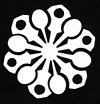
The final tie of Boxelder Week reproduces artwork from the
Book of Kells, one of the world's most renowned manuscripts. It was completed around 800 A.D., the work of at least two Irish monks in the
monastery of St. Columba on the island of
Iona, off Scotland's west coast. The book contains 680 pages of calfskin vellum (an additional 30 have been lost), all but two of which are illustrated, and without any repeat of patterns. Transcribed therein are the four Gospels in Latin and some miscellanea (Hebrew names and the Eusebain canons). The book acquired its name after being moved to
Kells Monastery in Ireland in the 9th century, as protection from Viking raids. That didn't stop it from being stolen in 1007, however, though the book was quickly recovered, minus its bejewelled cover. The
Book of Kells was given to
Trinity College of Dublin in 1661, and remains there today. I'm afraid I couldn't find what the fish and fabulous tracery on this tie depict; Boxelder's Kells line is no longer available, and is not displayed on the website. So if you know, please leave that information in a comment. (I have a feeling the incredibly knowledgeable
Mike S. will know...)
But the big news of the day is, new clothes from
Lands' End! Why am I always going on about Lands' End, you ask? (Or not.) Because it's the only place I can get pants that
actually fit! You see, the clothing manufacturers have decided that mens' legs are sized in increments of two inches, or that men will be happy with their pants if they are within two inches of the correct length. If you need a 32½ inch inseam, for instance, you are fated to walk around with your pants just a little too short (or worse, if they shrink), or to be walking on your pants hems because 34 inches is just too long. But with
Lands' End, you can specify your inseam to the quarter inch! What a luxury, to wear pants with a hem that just breaks over the instep and hangs straight down in back to the midpoint of the shoe.
 In Danny DeVito's Death to Smoochy (written by Adam Resnick), Robin Williams plays children's show host "Rainbow Randolph." But off the set he is a crass and greedy man, who justifies every bad thing he does by saying, "I'm Rainbow f@#&in' Randolph!" Which is what I can't help saying whenever I put on this shirt! It doesn't get as much wear as my solid-color shirts because it's hard to find non-solid-color ties to go with it. This recently-acquired floral tie by Bernard Chaix of France (with a little touch of Peter Max) goes pretty well; or close enough for government work, as they say. (Did I mention I am a state employee?)
In Danny DeVito's Death to Smoochy (written by Adam Resnick), Robin Williams plays children's show host "Rainbow Randolph." But off the set he is a crass and greedy man, who justifies every bad thing he does by saying, "I'm Rainbow f@#&in' Randolph!" Which is what I can't help saying whenever I put on this shirt! It doesn't get as much wear as my solid-color shirts because it's hard to find non-solid-color ties to go with it. This recently-acquired floral tie by Bernard Chaix of France (with a little touch of Peter Max) goes pretty well; or close enough for government work, as they say. (Did I mention I am a state employee?)





















